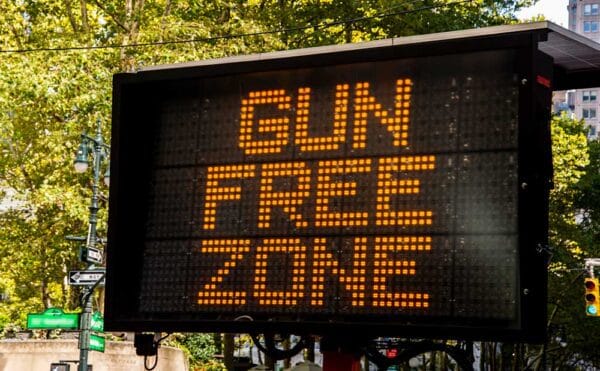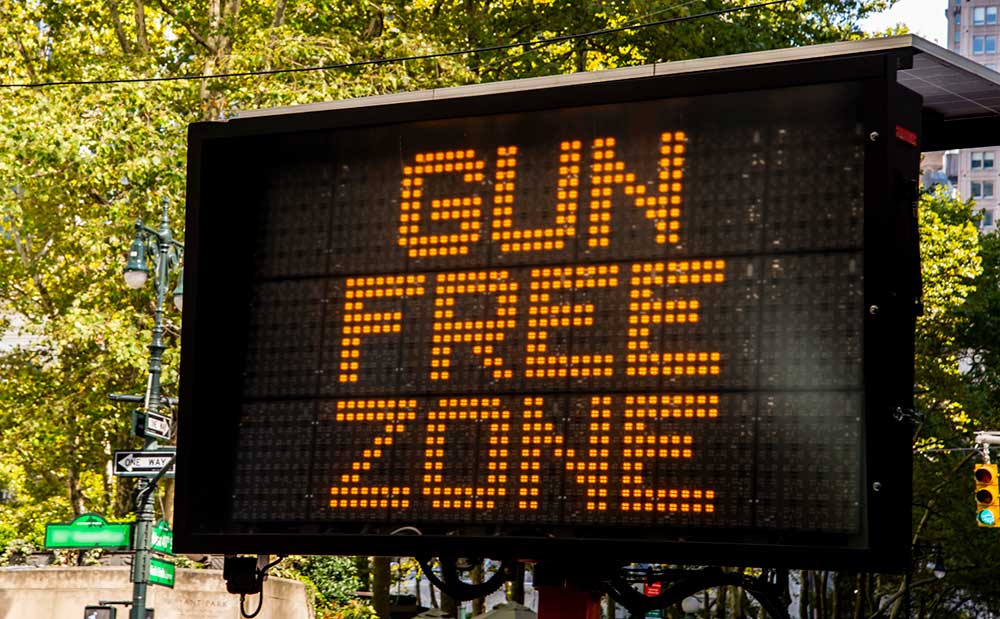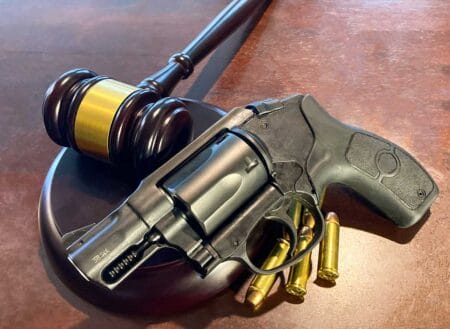
Unsympathetic defendants make for bad precedents. This is what happened in the Rahimi case, where the Supreme Court opened the door a crack, allowing judges to believe they can create more exceptions to Second Amendment rights. Rahimi is cited as the reason for the upholding of the Gun Free School Zone Act in the Fifth Circuit.
On January 29, 2023, 25-year-old Ahmed Adballa Allam had been living and traveling around the United States in his father’s Toyota RAV4 since July of 2022. He had purchased an AR-15 type rifle in Pennsylvania on the way to California. He had traveled to California and then to Texas sometime in early January 2023. Allam insisted on camping in the RAV4 near St. Anthony Cathedral Basilica School or near Temple Emanuel, a Jewish Synagogue in Beaumont, Texas.
The principal of the school was concerned about Allam’s actions and called the police several times per day. School staff and parents repeatedly contacted Allam and asked him to leave. Members of the Synagogue also asked him to leave several times. Until Allam was arrested, he had been contacted by police upwards of nine times. From 12newsnow.com:
On January 29, 2023, Beaumont Police received multiple calls about a suspicious vehicle around St. Anthony Cathedral Basilica School and Temple Emanuel. The callers said a man in a black Toyota Rav 4 with New York license plates was parked across the street and staying there for hours and even days at a time.
On January 29, Allam started to move the SUV from its parked position and was immediately stopped for a traffic violation. The officer called for backup. After failing to comply with officers’ instructions, Allam was arrested, and the SUV was searched as part of an inventory. Among other things, they found the AR-15, unloaded, in its original cardboard box, a loaded 30-round magazine, and 150 rounds of ammunition. Even a small, weak lock on the cardboard box would have met the requirement for the rifle to be in a “locked case”. From findlaw.com:
On Sunday afternoon, January 29, a school parent confronted Allam, who was sitting in his SUV parked adjacent to the school, and asked him to leave the area. Allam responded that he had a “mission” and that no one would ever see him again after Monday. Alarmed by Allam’s ominous statement and based on a strong suspicion that Allam possessed a gun, the parent immediately prompted BPD to post an officer near Allam’s SUV. Later that Sunday, when Allam began to drive the SUV from its parked location, the officer stopped him for various alleged traffic violations.2
In the search of Allam’s possessions, texts were found about Jihad, killing cats, and the legitimacy of rape and murder during Jihad.
A grand jury returned a single charge of possessing a firearm in a Gun Free School Zone. The case was heard in the federal district court: United States District Court, E.D. Texas. UNITED STATES of America v. Ahmed Adballa ALLAM CASE NO. 1:23-CR-10 Decided June 14, 2023. The court could not find a historical precedent.
Therefore, the Government has failed to show that the 1,000-foot zone around a school should be included in the Supreme Court’s identification of “schools” as sensitive places, or that it is analogous to the sensitive places previously identified by the Supreme Court, such that it should be considered a new sensitive place.
Unable to find a historical precedent for a gun free zone (GFSZ) outside of school property, the court decided to create a new exception where the exercise of Second Amendment rights could be infringed – the “buffer zone”. The court reasoned it could do this because “school shootings” were an “unprecedented societal concern“.
The court is of the opinion that the prevalence of school shootings—protection from which is one of the aims of § 922(q)(2)(A)’s enactment—in this modern era, is certainly an “unprecedented societal concern.”
Only one law about a firearms “buffer zone” existed during the Revolutionary era. The Delaware state Constitution created a buffer zone around polling places during the Revolutionary war in 1776, during the founding era. It applied to “Battalions or Companies, not individuals. It only applied on election days. It was removed from the Delaware Constitution one year after the Second Amendment was ratified. No further “buffer zone” laws were enacted until well after the Civil War, when a few were enacted from 1870 on. There have been school shootings since the colonial era, just not as frequently as present.
The court makes a strained comparison that the threat to schools continues all the time (even when the school is not open!), therefore, a permanent, continual law is acceptable! The court used the Rahimi case as a lever to open this loophole.
As detailed above, § 922(q)(2)(A)’s prohibition on the possession of firearms within 1,000 feet of school property is not “an ‘outlier[ ] that our ancestors would never have accepted.’ ” Rahimi, 61 F.4th at 460 (quoting Bruen, 142 S. Ct. at 2133). Therefore, the statute is constitutional, and both Allam’s facial and as-applied challenges fail. Accordingly, Allam’s Motion to Dismiss the Indictment (#22) is DENIED.
The three-judge panel for the Court of Appeals for the Fifth Circuit goes even further afield. It relies on the 14th-century Statute of Northampton, which had nothing to do with schools and had become dormant before the English Bill of Rights was written.
It appears the Fifth Circuit panel was heavily influenced by an unsympathetic defendant. If a law can be used against an unsympathetic defendant, it can be used against you. From Courtlistener.com:
By contrast, Allam focuses heavily on the lack of a conclusive historical analogue to § 922(q)(2)(A)’s 1,000-foot buffer zone. But this focus misses the mark. We need not—and do not—fix how far a buffer zone may stretch before it runs afoul of the Second Amendment to decide Allam’s as-applied claim. Section 922(q)(2)(A)’s buffer zone needed to do very little work here, if any. Allam had camped out only 40 feet from school grounds. His SUV was parked on a street bordering campus—adjacent to school zone lighting and signage—at a location where students crossed routinely to get to the off-campus basilica. He was also behaving erratically and menacingly, so much so that people repeatedly called the police, and St. Anthony changed its students’ routines and traffic patterns. As applied here, § 922(q)(2)(A) is “relevantly similar” to the Statute of Northampton and going-armed laws and the (limited) historical examples of firearm restrictions in educational settings and buffer zones around polling places, which corroborate the constitutionality of disarming a visibly threatening individual as near a school as Allam was.17
With all the “menacing” the local police should have found a more local solution than the GFSZA. This is an “as applied” case instead of a facial challenge. “As applied” cases are not supposed to be as precedential as facial challenges. In reality, the difference between “as applied” and facial challenges is eroding.
This is a poor decision. Challenges to the Gun Free School Zone Act are not easy to come by, because federal prosecutors have been wary of challenges that would show how bad the law is. In the Ninth Circuit, a much more sympathetic defendant has appealed a conviction under the GFSZ. We should know if the three-judge panel in the Ninth Circuit will be willing to accept the Second Amendment challenge in a few months. The Ninth Circuit has been hostile to Second Amendment cases.
About Dean Weingarten:
Dean Weingarten has been a peace officer, a military officer, was on the University of Wisconsin Pistol Team for four years, and was first certified to teach firearms safety in 1973. He taught the Arizona concealed carry course for fifteen years until the goal of Constitutional Carry was attained. He has degrees in meteorology and mining engineering, and retired from the Department of Defense after a 30 year career in Army Research, Development, Testing, and Evaluation.







The federal GFSZA is the most unconstitutional garbage on the books right now. It needs to be tossed out.
I am soooooo tired of seeing the Statute of Northampton used in any US legal documents or opinions. It was from England. Last time I checked, the US overthrew the Brit’s laws about 250 years ago.
So the judges used interest balancing and singular examples of ancient and defunct laws, both methods counseled against by SCOTUS. I grant that Allam was a likely a school shooting in waiting and it is good that he was interrupted. But the GFSZ act should be ruled unconstitutional or erased from the law along with the firearms on P.O. property laws.
Legislatures and judiciaries are overpopulated with ninnies–primarily women, who, by dint of a pernicious amalgam of ignorance, hubris, indifference to logic, and slavery to emotion, seek to legislate and rule after the fashion of mothers looking after toddlers. The individuals in question fear firearms and believe in their hearts that all the world should be made a gun-free zone. Just as gazelles–creatures born to live in eternal fear of being preyed upon–would see the Serengeti emptied of teeth and claws, so female judges and politicians and the the fey men in thrall thereto aspire in perpetuity to actualize their shared… Read more »
GFZs are just a great big billboard announcing “Hey, defenseless people here. Easy targets. Shooting opportunities limited to law enforcement response time.”
>He was also behaving erratically and menacingly<
Then arrest him for that.
Leave my guns alone – or else.
HLB
How does someone who lives in their car afford lawyers to take this case all the way to the appellate court? Something is fishy here.
Concealed means concealed. If there is a metal detector, I won’t carry inside if I have to do business there. Hell, our local post office had detectors but they no longer work and I carry inside there.
That ruling is in direct violation of Article I, Section 8, Clause 15 of the Constitution. I would also like to know how that ruling holds with Miranda v Arizona – “Where rights secured by the Constitution are involved, there can be no rule making or legislation which would abrogate them.” Clause 15 arises from the history and legislation of the colonies and states •[1619] “All persons whatsoever upon the Sabaoth daye shall frequent divine service * * * , and all suche as beare arms shall bring their pieces swordes, poulder and shotte.” •[1624 and 1632] “That no man… Read more »
The fact that different courts can pick and choose whichever law or ruling they FEEL meets their needs based solely upon their FEELINGS about guns and how much they hate them shows that our system needs an overhaul. You shouldn’t be able to go judge shopping to get what you want and the fact that when a blue court hears something the outcome is different than when a red court hears something supports my statement. All courts should draw the same conclusions. In addition, the S court who has the final decision over the lower courts shouldn’t have to get… Read more »